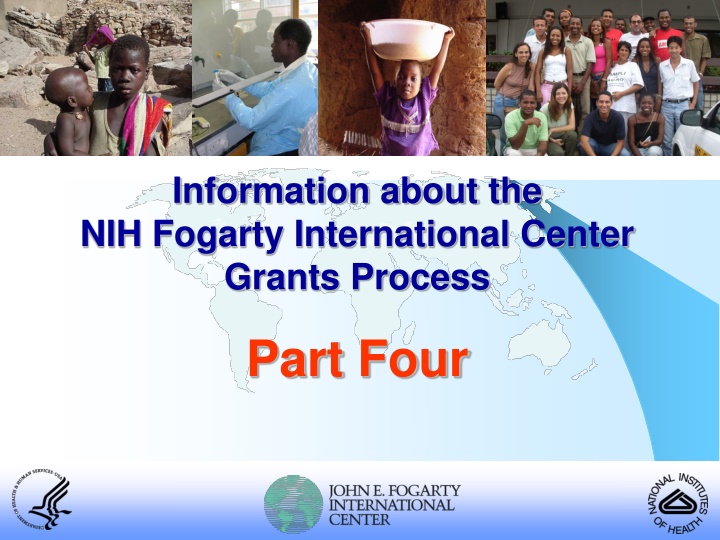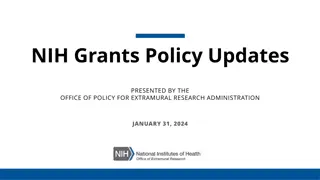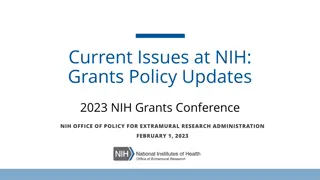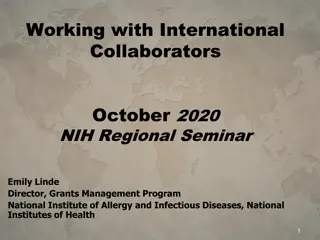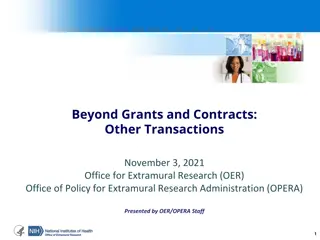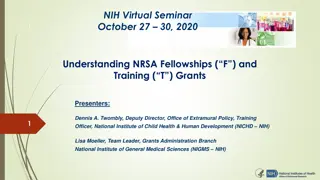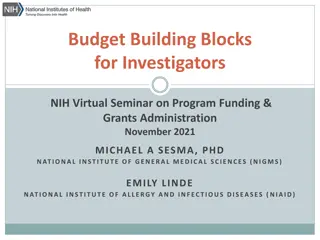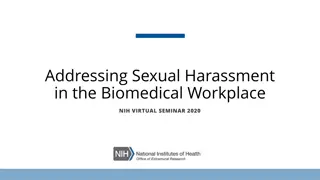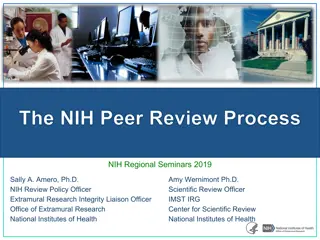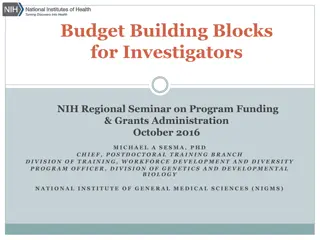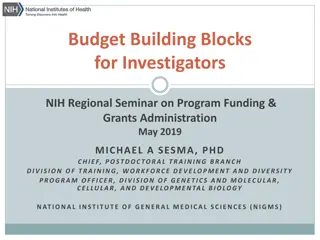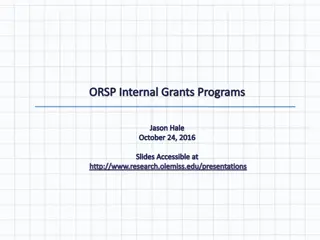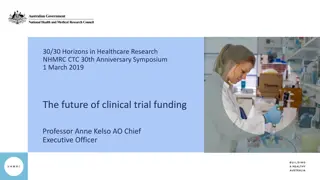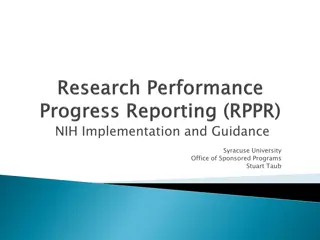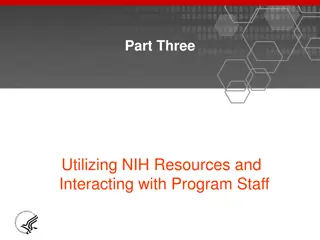NIH Fogarty International Center Grants Process Part Four
The NIH Fogarty International Center plays a crucial role in supporting global health research through grant awards. The Center is part of the National Institutes of Health (NIH), which supports both intramural and extramural research. Extramural research receives over 80% of NIH funding through competitive grants, benefitting thousands of researchers worldwide. The Fogarty International Center, along with other NIH institutes and centers, contributes to advancing biomedical and health research globally.
Download Presentation

Please find below an Image/Link to download the presentation.
The content on the website is provided AS IS for your information and personal use only. It may not be sold, licensed, or shared on other websites without obtaining consent from the author.If you encounter any issues during the download, it is possible that the publisher has removed the file from their server.
You are allowed to download the files provided on this website for personal or commercial use, subject to the condition that they are used lawfully. All files are the property of their respective owners.
The content on the website is provided AS IS for your information and personal use only. It may not be sold, licensed, or shared on other websites without obtaining consent from the author.
E N D
Presentation Transcript
Information about the NIH Fogarty International Center Grants Process Part Four
US Department of Health and Human Services The Secretary Deputy Secretary Health Resources and Services Administration (HRSA) Administration for Children and Families (ACF) Administration on Aging (AoA) Food and Drug Administration (FDA) Agency for Health Care Policy and Research (AHCPR) Centers for Medicare and Medicaid Services (CMS) Indian Health Services (IHS) National Institutes of Health (NIH) Centers for Disease Control and Prevention (CDC) Agency for Toxic Substances and Disease Registry (ATSDR) Substance Abuse and Mental Health Services Administration (SAMHSA) Program Support Center (PSC)
The National Institutes of Health Office of the Director National Institute of Arthritis and Musculoskeletal and Skin Diseases National Institute of Child Health and Human Development National Institute of Allergy and Infectious Diseases National Institute on Alcohol Abuse and Alcoholism National Institute on Aging National Cancer Institute National Institute on Deafness and Other Communication Disorders National Institute of Dental and Craniofacial Research National Institute of Diabetes and Digestive and Kidney Diseases National Institute of Environmental Health Sciences National Institute on Drug Abuse National Eye Institute National Institute of Neurological Disorders and Stroke National Institute of General Medical Sciences National Heart, Lung, and Blood Institute National Human Genome Research Institute National Institute of Mental Health National Institute of Nursing Research National Center for Complementary and Alternative Medicine National Institute of Biomedical Imaging and Bioengineering National Center on Minority Health and Health Disparities National Center for Research Resources Fogarty International Center National Library of Medicine 24 of the Institutes and Centers make grant awards. The three centers to the right do not make grant awards Center for Information Technology Center for Scientific Review Clinical Center
The NIH Supports Intramural and Extramural Research Intramural Research About 11% of the NIH's budget supports projects conducted by nearly 6,000 scientists in its own laboratories, most of which are on the NIH campus in Bethesda, Maryland. Extramural Research More than 80% of the NIH's funding is awarded through almost 50,000 competitive grants to more than 300,000 researchers at more than 2,500 universities, medical schools, and other research institutions in every state and around the world.
Breakdown Budget for NIH $36.2 Billion 9.9% 6.0% 2.5% 9.7% 53.7% 11.1% 2.2% 5.0% Research Project Grants (53.7%) Research Centers (9.86%) Other Research (5.96%) Research Training (2.53%) R&D Contracts (9.67%) Intramural Research (11.07%) Research Mgmt & Support (5.0%) All Other (2.21%) 5
The National Institutes of Health Extramural Funding Instruments The NIH awarding institutes use three major instruments (thru FOA s) to provide funds to Organizations outside the NIH to accomplish program goals. 1) Contracts 2) Grants 3) Cooperative agreements Contracts are used by the NIH to get specific projects, or deliverables, accomplished within a certain timeframe. The remaining slides in this presentation focus on grants and cooperative agreements.
The NIH Grants and Cooperative Agreements: How are they used? Grants: The NIH provides funds to support a proposed project. The NIH provides assistance. Cooperative Agreements: The NIH is a full partner in the project. The NIH provides assistance and substantial program involvement.
Applications for the NIH Grants and Cooperative Agreements Grants and Cooperative Agreements are normally received by NIH in three ways thru FOA s: 1) Unsolicited Grant Application - CSR, NIH receives these applications. Grants.gov lists unsolicited grants as Parent Announcements. 2) Program Announcement (PA) Institutes or centers invite applications in general scientific areas of research. Funds, generally, are not set aside in advance for these projects. 3) Request for Application (RFA) - Institutes or centers invite applications in a well-defined scientific research area. Specific funds are set aside in advance for these projects.
Duel Peer Review System The first level of review is carried out by a Scientific Review Group (SRG) composed primarily of non-federal scientists who have expertise in relevant scientific disciplines, current research areas, and technical qualifications. SRG members: - Prepare a written critique for each application assigned, based on review criteria and judgment of merit - Assign a numerical score to each scored review criterion - Make recommendations concerning the scientific and technical merit of applications under review, in the form of final written comments and numerical scores - Make recommendations concerning protections for human subjects; inclusion of women, minorities, and children in clinical research; welfare of vertebrate animals; and other areas as applicable for the application - Make recommendations concerning appropriateness of budget
Duel Review System The second level of review is performed by Institute and Center (IC) National Advisory Councils or Boards. Councils are composed of both scientific and public representatives chosen for their expertise, interest, or activity in matters related to health and disease.
Dual Review System for the NIH Grant Applications Scientific Review Group (SRG) Provides Initial Scientific Merit Review of Grant Applications Rates Applications and makes Recommendations for Appropriate Level of Support and Duration of Award Second Level of Review: Institute or Center Council Assesses Quality of SRG Review of Grant Applications Makes Recommendation to Institute Staff on Funding Evaluates Program Priorities and Relevance Advises on Policy
Review Process for Grant Applications Submitted to CSR, NIH National Institutes of Health School or Other Research Center Research Grant Application Center for Scientific Review Assigns to IRG/Study Section & IC Study Section Initiates Research Idea Submits Application Evaluates for Scientific Merit Institute Evaluates for Program Relevance Advisory Councils and Boards Allocates Funds Conducts Research NIH Feedback to Congress Recommends Action Institute Director Takes final action for NIH Director
Peer Review The peer review of applications from foreign institutions is the same as that for applications from U.S. institutions and is described in the NIH Grants Policy Statement (10/12) Chapter 2.4: The Peer Review Process. In addition, the following are assessed as part of the review process and award decisions for applications from foreign institutions: Whether the project presents special opportunities for furthering research programs through the use of unusual talent, resources, populations, or environmental conditions in other countries that are not readily available in the United States or that augment existing U.S. resources. Whether the proposed project has specific relevance to the mission and objectives of the IC and has the potential for significantly advancing the health sciences in the United States
Project Monitoring Awards can be made normally from 1-5 years (except for multi-year awards) Each year grantees need to submit a noncompeting application detailing progress, budget information, and any changes At the end of the competitive segment, they provide a final progress report
Project Monitoring Grants are not like contracts in outcomes Breakthroughs or advances in science are usually brought to the attention of the U.S. Congress Success with a grant can result in publications and continued funding
Setting Research Priorities Some ways priorities are determined Portfolio analysis or evaluation Idea s from an NIH Institute s scientific staff Idea s from the NIH Institute s Council or Board Idea s from other Advisory or External Groups Areas of emphasis from Congress Areas of emphasis from the president The Institute Director makes final decisions
NIH Peer Review and Grant Writing Movies More information about the NIH peer review process see: https://grants.nih.gov/grants/peer-review.htm YouTube Video about the NIH Peer Review Process: https://www.youtube.com/watch?v=fBDxI6l4dOA
For More Information NIH website: www.nih.gov NIH Office of Extramural Research website: http://grants.nih.gov/gra nts/oer.htm Question? Bruce Butrum, Chief GMO, FIC
